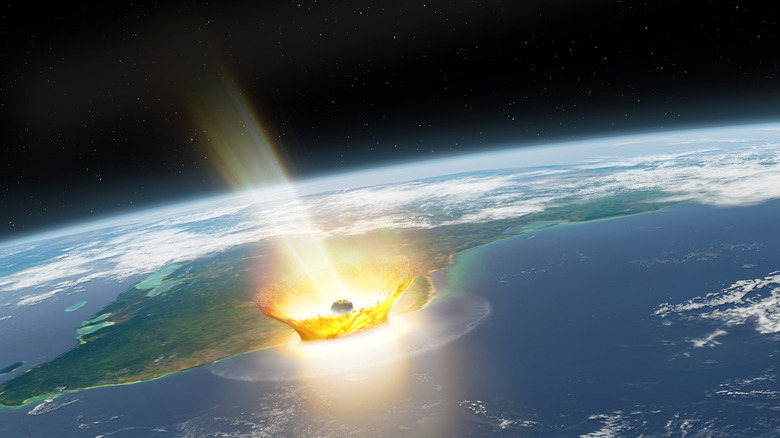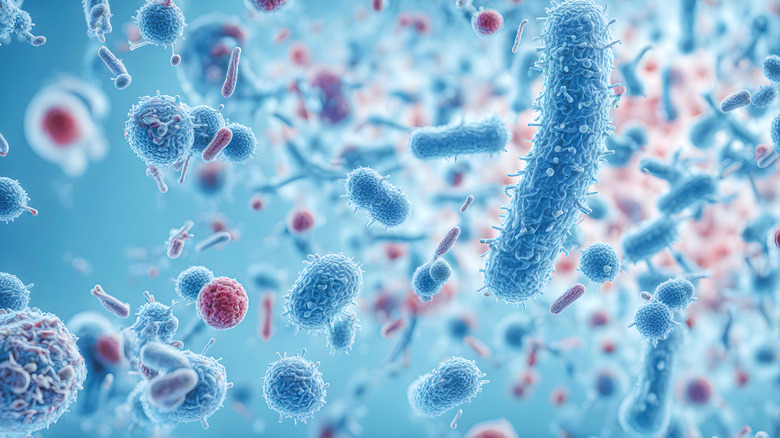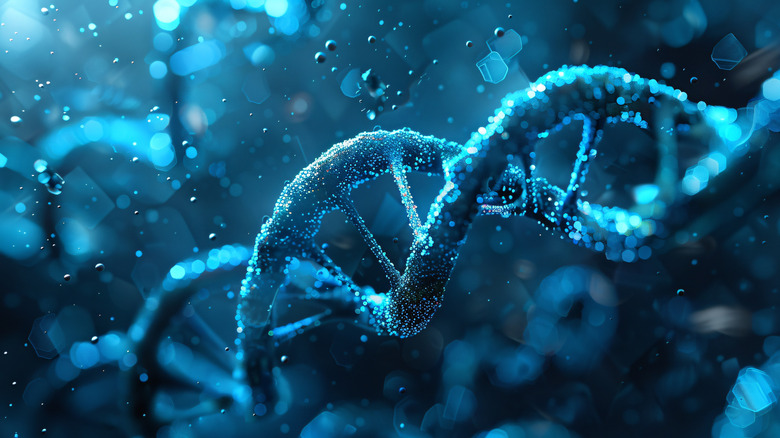The Meteor Strike That Likely Sped Up Evolution
A new earth-science article published in September of 2024 has thrown the common understanding of meteorite strikes on Earth into question. The paper challenges the reasonable assumption that a giant space rock smashing into the planet is a bad thing for evolution — at least for early life forms. In fact, the paper suggests that one such event in Earth's geological history may have even helped speed up evolution. But the impact in question was quite a bit different from the one that killed off the dinosaurs.
Out of the five mass extinctions that have occurred on Earth, the most recent was triggered by a massive meteorite that struck the area now known as the Yucatán Peninsula. This impact, called the K-T impactor, led to the extinction of all species of non-avian dinosaurs as well as over ¾ of every plant and animal species on Earth. But more than 3 billion years earlier, a meteorite impact much bigger hit the Earth with a much different outcome.
The new article, published in Proceedings of the National Academy of Sciences (PNAS), is a collaboration between researchers from Stanford, Harvard, and ETH Zurich. It explores the effects of a meteorite impact, called the S2 impactor, that evidently occurred 3.2 billion years ago. The space rock was around 50-200 times bigger than the dinosaur-killing K-T impactor. Yet rather than triggering a mass extinction, the S2 impactor helped boost the rate of evolution.
The paper paints a clear picture of three main ways the impact could have sped up evolution. The biggest catalyzer was the violent dissemination of materials like iron across the globe. Covered in vast oceans of nutrient-starved microbes, the Earth was primed for an elemental shakedown.
Why early microbes loved getting smashed by meteorites
There has been a large body of research dedicated to exploring the effects of meteorite impacts on Earth's ecosystems, possibly encouraged by the popular interest in the death of the dinosaurs. But looking back thousands of millions of years, the evidence gets murky. And for the S2 impact event, which occurred 3.2 billion years ago, there's a lot of uncertainty. Nonetheless, many geological clues point to several powerful meteoric collisions during the Paleoarchean Era, events that fall smack dab in the middle of the golden age of prokaryotic life.
The new PNAS article proposes three ways that a massive meteoric impact could have catalyzed evolutionary processes. First, it would have generated a massive tsunami. This great wave would have churned up the iron-rich materials in the deep oceans, delivering the metals to shallower waters where early life congregated most abundantly in microbial mats. This new influx of iron isotopes in Earth's early types of ecosystems could have helped boost the available materials for evolutionary experimentation.
The second catalyst was the intense heat generated from the impact — heat which would have blasted water vapor into the atmosphere and even evaporated huge swaths of ocean water. As a result, extreme volumes of precipitation would have fallen as rain, eroding the land masses that existed at the time and draining their minerals into coastal areas. To put it simply, a meteorite impact could create intense rains, and intense rains could help carry terrestrial materials to the primordial lifeforms hanging out around the coasts.
The third mechanism the 3.2-billion-year-old meteorite strike could have helped speed up evolution is a bit more jargony, so let's break it down.
The phosphorous delivery from space
The timeline of life starts before life began, when the materials necessary for biology began forming in the fiery hellscape of the Earth. This was the Hadean Eon, a moment in geological history 4.6 billion years ago, when the planet was a ball of lava and toxic gases. In this fledgling period, free-flying meteors smashed into the early Earth, easily reaching the surface thanks to their greater numbers and Earth's lack of an atmosphere to burn them up. This heavy bombardment stage, while violent, is believed to have seeded the building blocks of life, including liquid water.
By around 1.4 billion years later, the Earth had been transformed into a water world with single-celled microbial life populating its shores and hydrothermal vents. Yet evidently, the relative peace was interrupted by the S2 impact event, which collided with the Earth at such a speed that the colossal meteorite likely vaporized upon impact. That vaporization is what's behind the third mechanism through which the S2 meteor strike could have boosted evolution.
As mentioned, the impact churned up iron deposits settled in deep waters, carrying the minerals to the shallower waters where microbes congregated. But another element vital to life was also scarce in those shallow waters prior to the impact — phosphorus. The researchers found a notable increase in microbes that consume phosphorus immediately after the impact event, suggesting that the meteorite, as large as 36 miles in diameter, vaporized upon impact and showered the planet with its materials. In other words, the meteor brought life-giving phosphorus from the sky. Thus, with a new abundance of essential elements to work with, life received an evolutionary catalyst from a massive space rock.


